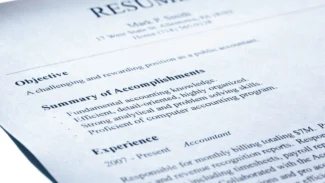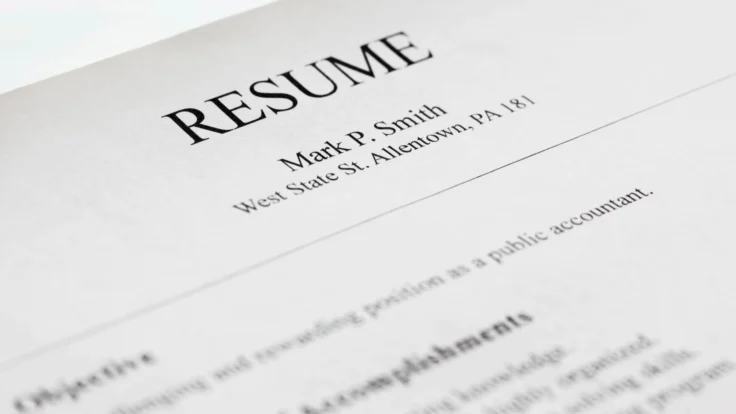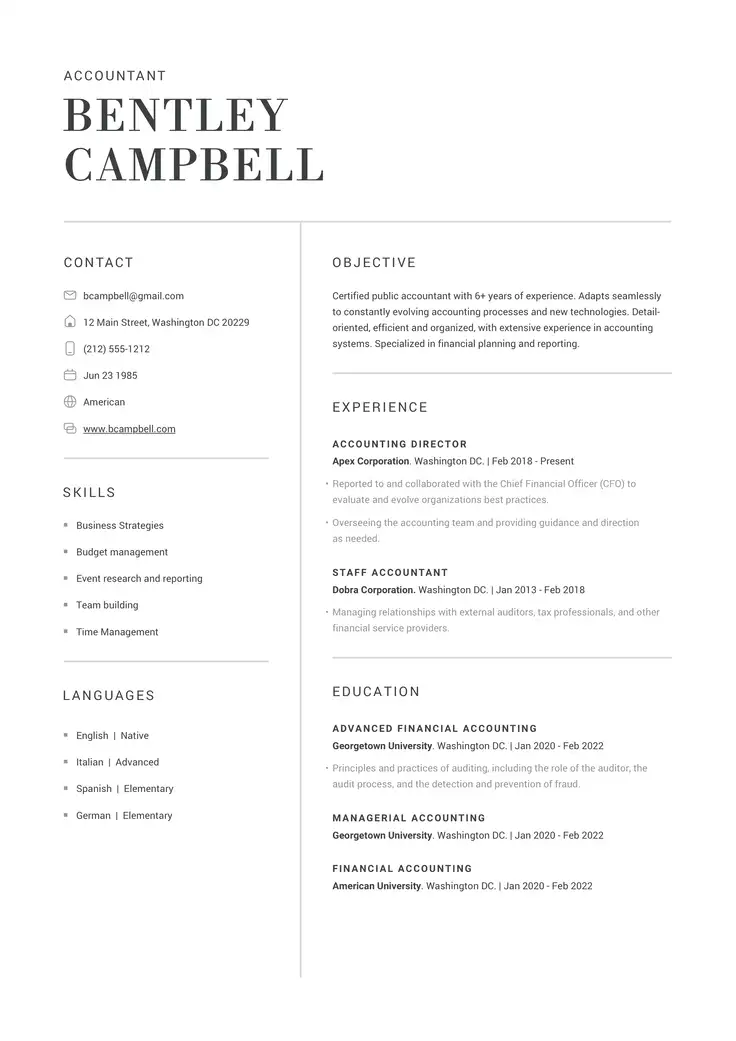For some, a resume can be a lot like a newspaper. The most important information is in the small print however, what really motivates people to continue reading are the headlines. Many hiring managers look at a resume the same way.
If you want to grab their attention and get them to continue reading you’ll need a resume headline that works.
With an innovative resume builder and our advice below, you’ll be able to quickly tailor your headline to the job you want and get a hiring manager interested in reading the rest of your resume.
What Is a Resume Headline?
If you’ve heard of headlines and titles on a resume you may be wondering if they are one and the same.
Yes, resume titles and resume headlines refer to the same thing – a short sentence that appears below your name on your resume.
Your headline has one mission. To get the employer to keep reading.
A well-written headline will highlight your experience and skills in a way that makes a good first impression and catch the attention of the hiring manager.
Novelist Stephen King said of his writings, “An opening line should say: Listen. Come in here. You want to know about this.”
Your resume headline must have the same effect.
Difference between resume headlines and resume profiles
It’s crucial to know the difference between a “Resume Headline” and a “Resume Profile”. Both serve unique functions and can be instrumental in making your application stand out.
Resume Headline
The resume headline is a brief and concise statement of your professional expertise and skills. Here’s what you need to know:
- It’s essentially the title of your professional narrative
- It’s placed at the top of your resume, following your contact information
- It’s a phrase that shows off your key skills and experiences
Resume Profile
Resume profiles on the other hand, provide a more comprehensive overview of your professional identity. It includes:
- A more detailed summary of your skills, experiences, and goals.
- Typically located under the headline or at the beginning of the resume.
- It covers your professional achievements and career aspirations.
To sum it up, the headline is a quick, attention-grabbing statement, while the profile offers a more detailed and comprehensive view of your professional persona. Both elements should be tailored to your application to highlight your most relevant qualifications.
Benefits of a well-written resume headline
You may be wondering is a creative resume headline worth the trouble. After all, it’s the job of the hiring manager to read each candidate’s resume, right?
Not so fast.
An employer should read each candidate’s application, however, it doesn’t mean that they’ll do it. That’s where your headline comes in.
It will offer you some direct advantages that can pack a powerful punch when it comes to capturing the attention of recruiters. Let’s dive into the specific benefits:
- Attracts Attention: A well-crafted headline draws the attention of recruiters and encourages them to further examine your resume.
- Shows Your Value Instantly: Headlines immediately communicate your potential value. It tells the employer why you’re the perfect fit for the role, without them having to dig through your entire resume.
- Helps with Applicant Tracking Systems (ATS): Many employers use ATS to filter resumes. Including keywords from the job description in your headline can improve your chances of passing these initial screening tools.
- Highlights Your Specialization: If you have a particular area of expertise, your headline is the perfect place to showcase it. This can be particularly beneficial in niche industries or for specialized roles.
- Promotes Personal Branding: A headline summarizes your professional identity, contributing to your personal brand.
- Demonstrates Focus and Direction: A clear and targeted headline shows you’re focused and know exactly what you’re looking for in your career.
With the right keywords and length, you should be able to impress any employer and get your application to begin on the right foot.
When to Use a Resume Headline
Resume titles fit in well on virtually any resume. They can be especially useful when you are:
- Trying to highlight your skills and experience
- Changing careers
- Applying for competitive positions
A headline also plays a crucial role when navigating career transitions. Despite having a different career history, a well-crafted headline can stress your transferable skills and demonstrate your potential to succeed in a new role.
For competitive roles, it can also provide a significant edge. In crowded job markets, it sets you apart by quickly communicating what only you can offer to a position. It makes an immediate, positive impression, increasing your chances of standing out from the competition.
It can also be used in just about any circumstance. With the right headline you can add value by putting the spotlight on your relevant skills and/or experience right away.
Steps to Writing an Engaging Resume Headline
Crafting a compelling resume headline is an art. It’s your golden ticket to grabbing a recruiter’s attention. Here’s a step-by-step guide to help you create a headline that’s sure to turn heads.
- Understand the job description: First off, get familiar with the job description. What skills, experience, and qualifications are they looking for? Your headline should echo these requirements.
- Highlight your key skills: Identify your key skills that align with the job. Are you a ‘data-driven marketing guru’ or an ‘accomplished project manager with Agile expertise’? Let your headline do the talking.
- Showcase your experience: Experience can be a game-changer. If you’ve got years under your belt in a specific role or industry, flaunt it in your headline. For example, ‘Veteran Graphic Designer with 10+ Years in the Gaming Industry’.
- Use relevant keywords: Add some SEO magic to your resume by using keywords from the job description. This not only shows you’re a perfect fit but also helps your resume get past any Applicant Tracking Systems (ATS).
- Keep it compact: Remember, a headline should be short and sweet. Aim for less than 10 words. The goal is to make a big impact with a brief statement.
- Proofread and edit: Even the smallest typo can be a deal-breaker. Proofread your headline and ask a friend or mentor to review it.
- Tailor it for each job: One size does not fit all when it comes to resume headlines. Customize your headline for each job application. What works for a software startup may not work for a corporate law firm.
Here’s an example of a solid student resume headline that should come out if you follow these steps correctly:
“Dean’s List Business Student with Strong Leadership Experience in Campus Organizations”
Remember, your headline is the first thing recruiters see. Make it count!
Tips for Writing a Great Resume Headline
Knowing the steps you have to take is essential, but if you can add in some solid strategies and ideas you’ll earn some extra points with employers. You can use the following “ingredients” to create a good resume headline.
- Use a positive adjective that describes your personality or work style.
- Name your position title.
- Cite an accomplishment, such as your years of experience, a statistic, or a special skill.
Just like the rest of your resume, don’t forget to use the job description as a reference to understand the keywords you should use and what skills and experience you should showcase.
💡Tip
Don’t stop with just one resume title. Write several, and choose the one with the most “punch.” You can also keep a few saved on your computer and switch them up, using the most relevant for each job you apply to.
How to write a headline for an entry-level position
Crafting a headline for a resume with no experience on it can seem tricky, but with the right approach, you can make a strong impression. Here are some key points to consider:
- Leverage Your Strengths: Highlight academic achievements, extracurricular activities, or relevant coursework. Even without professional experience, you have accomplishments to display.
- Understand the Job Requirements: The same as a professional who has worked for some time, make sure to align your headline with the skills and qualifications specified in the job description.
- Stay relevant: You may feel a bit desperate when it comes to adding skills and anything to your experience section, but make sure it relates to the job you’re applying to.
Here’s an example of how you can write your headline if you’re lacking experience:
“Detail-Oriented Business Graduate with Strong Organizational Skills, Seeking Entry-Level Administrative Assistant Role”
This is great to draw inspiration from as it targets the position with an emphasis on relevant skills, and it states exactly what position they are looking for.
Resume Title Examples for Any Job
Below, you will find a list of resume title examples centered around different careers and experiences. Each resume headline example is fictional, but it represents what you could do when writing yours.
Pay special attention to the positive adjectives used at the beginning of each headline. Why not pick a headline example that you like and customize it to fit your unique situation?
- Hardworking administrative assistant with 3+ years of experience in the real estate market.
- Intuitive business analyst with 6 years of excellence in DevOps.
- Certified medical assistant with a strong background in emergency care.
- A cutting-edge digital marketer who landed $5 million in sales last year.
- Diplomatic law office receptionist with a diversified cultural understanding.
- Self-motivated office assistant with 5 years of experience in a busy shipping firm.
- Passionate high school teacher with experience in ESL and IEPS.
- Enthusiastic retail clerk with 4 years of experience in outdoor goods.
- Friendly cashier and 3-time recipient of Employee of the Month honors.
- Graphic designer with 7 years of experience working for national adverting agencies.
- Accomplished growth marketing manager with 10 years in sales.
- Hard-working CNA with 5+ years of experience and Nightingale Award recipient.
- Insightful IT manager with a history of beating deadlines and coming in under budget.
- Likable floor manager with 12 years of experience.
- Experienced mechanical engineer with a 7-year track record of boosting productivity.
- Multilingual licensed RN with 10+ years of experience in pediatrics.
- Personable sales representative who regularly exceeds sales targets by 20 percent.
- Resourceful project manager with 12 years of experience.
- Sociable sales associate who attained a 25 percent revenue increase.
- Skilled bartender with 6 years of experience in Michelin-starred restaurants.
- Taste of the Town’s server of the year, Springfield, TN 2019.
- Prize-winning videographer featured at Sundance Film Festival.
- Reliable freelance writer with more than 3,000 online publications.
- Certified PMP Project Manager with 7+ Years of Experience in the Tech Industry.
- Full-Stack Software Developer Specializing in Java and Python with 5 Years of Experience.
- Creative Graphic Designer Specializing in Digital Marketing with Proficiency in Adobe Suite.
- PhD-Certified Data Scientist with Expertise in Machine Learning and Big Data Analysis
Did you notice that all of these examples are just one sentence in length? Some are a simple phrase rather than a complete sentence.
All are packed with information, and some are especially noticeable. Hiring managers might remember “that guy who won the award,” “the woman who made millions in sales,” or “that person with more than 15 years of experience” long after leafing through resumes.
Key Takeaways
Creating the right opening for your resume can be so impactful if you follow these strategies and tips. Just remember the following key details:
- Resume headlines are designed to grab the hiring manager’s attention, making them want to read more.
- Your resume headline should be short, one sentence or less.
- Include the most memorable accomplishments, skills, or experiences. These may be numerical statistics, required skills or licenses, or years of experience.
Along with this information, using tools like creative templates can also be a huge help when you’re trying to come up with something that will make your headline leap off the page.
Related Blog




